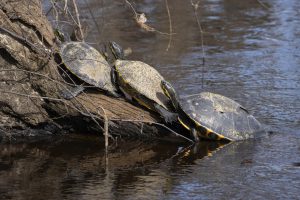Identifying North Florida river turtles can be quite challenging, given the fact that several species are collectively referred to as “streak-ed heads” by many people. Although you will not find this term in the scientific naming conventions, it is actually an apt description for many turtles in the Southeast that have dark skin with thin, yellow pinstripes on their head and neck. North Florida has at least half a dozen species that fall into this general grouping. They include the Suwannee cooter, river cooter, Florida cooter, chicken turtle, yellow-bellied slider and a couple of map turtles. We even have a disjunct population of Florida red-bellied turtles on the Apalachicola River that are isolated from the main group, which is restricted to peninsular Florida and extreme Southeastern Georgia. Overall, we have about 25 species of turtles in Florida.

Suwannee cooters at Lafayette Blue Springs, Lafayette County, Florida, 2021.
FWC Photo by Andy Wraithmell
As you might guess, the key to accurate river turtle identification lies in the details and the details can be tough to see. Most basking turtles tend to tumble off their logs into the water long before you are close enough to scrutinize their features. However, a few tips and tricks may improve your chances when going afield. A good pair of binoculars and a reptile field guide are must-haves. You need to be able to see if the yellow on the side of the head is a wide splash (as on the yellow-bellied slider), or a series of thin lines (as on various cooters). If the top shell (carapace) is very dark and the bottom shell (plastron) shows orange color, you might have a red-belly or Suwannee cooter (higher dome on red-belly, relatively). Two of our native species have what are referred to as “striped breeches”. When viewed from the rear, the stripes on the hind legs are vertically oriented on the yellow-bellied slider and the Florida chicken turtle. The chicken turtle is distinguished by a relatively narrower head and a wide, yellow stripe on the front legs. Separating the various cooter species gets a little trickier. You need to use characteristics like the pattern on the plastron, the occurrence of “hairpin-shaped” stripes on the head, or the pattern of lines on particular carapace scutes.
So how do you get those clues in the wild? A good telephoto lens may work if you are fortunate enough to own one. This will give you the opportunity to study detailed features at your leisure. Otherwise, you may not be able to identify a turtle to the species level. Getting close to a wary turtle is not easy. However, on busy stretches of our waterways, where wildlife are desensitized to people and boats, turtles generally have a wider comfort zone. Especially if you are in a canoe or kayak and minimize your movement and sound as you glide in for a better view. Lastly, go looking on a bright sunny day and your opportunities will vastly increase as turtles climb out of the water onto logs to soak up some of that good old Florida sunshine. One species that you should have no trouble naming when encountered, is the softshell turtle. Softshells will extend their extremely long neck upward when basking and their flexible, smooth shell will appear flattened in profile. They are the only turtles here with a tubular snout. Never try to pick one up if encountered crossing a road, as they do not hesitate to bite and have extremely sharp and powerful jaws. In general, even if you are confident in not getting nailed, you will probably be wrong, given the extremely long neck that can reach more than halfway back on the shell. Also, all of our water turtles have very sharp claws on their hind feet and will manage to get in a few good rakes before you decide to put them down, or worse yet, drop them on the pavement and injure them.
Now, when you think you are getting good at basking turtle identification, start looking for some of our less obvious, smaller species. These include stinkpots, musk turtles, mud turtles, map turtles and box turtles; all very cool critters. But if you think you want to pick up one of the cute little buggers, beware. Most of the little ones will bite too…hard! Believe me. Happy “turtling!”
- Recent Catch of a Bocourt Swimming Crab in Apalachicola Bay - November 22, 2024
- Damselfly Love - October 18, 2024
- Meet the Ocellated Flounder - June 28, 2024
